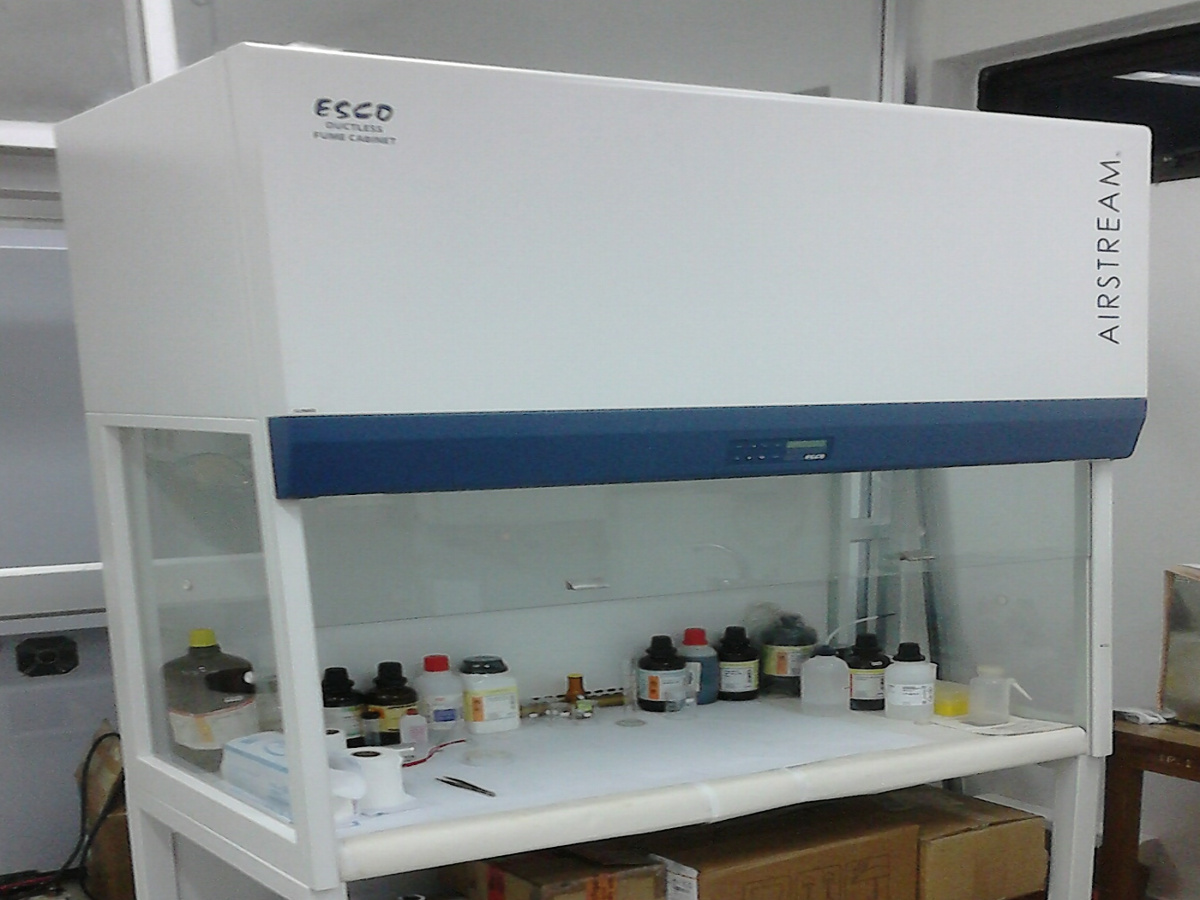Facilities
UV-Vis-NIR spectrometer Setup
UV-Vis-NIR spectrometer is one of the powerful tool for optical characterization of thin film solar cells mainly. It utilizes two light sources, one is Deuterium and other one is mercury, to study the transmission, reflection, and absorption properties of materials over the complete range of solar spectrum.One standard sample is used for calibration.
Model: UV-3101PC
Manufacturer: Shimadzu Corporation, Japan
Date of installation: ../../....
Features:
Wavelength Range: 190 - 3200 nm
Resolution: 0.1 nm
Photometric System: Double Beam, Direct Ratio measuring system
Light Sources: 50 W Halogen Lamp & Deuterium Lamp
Monochrometer: Diffraction-grating double monochrometer system
Detector: Photomultiplier R-928 for UV/Vis; PbS Cell for NIR
Manufacturer: Shimadzu Corporation, Japan
Date of installation: ../../....
Features:
Wavelength Range: 190 - 3200 nm
Resolution: 0.1 nm
Photometric System: Double Beam, Direct Ratio measuring system
Light Sources: 50 W Halogen Lamp & Deuterium Lamp
Monochrometer: Diffraction-grating double monochrometer system
Detector: Photomultiplier R-928 for UV/Vis; PbS Cell for NIR

Nano-patterning integrated MBE system
MBE is quite powerful tool for ultra-clean and controlled growth of thin films. Integration of a nano-patterning setup with MBE add much more functionality to it. A gamut of various nanoscale patterns can be fabricated on a class of materials including semiconductors, metal, and insulators. These nanoscale patterns are useful as templates for growth of multifunctional thin films. In-situ nano-patterning followed by the growth of thin films open up the way to fabricate oxide-free surface patterns for device applications.
Manufacturer: Prevac
Date of installation: December, 2015
Features:
Substrate heating: Halogen & Resistive
Heating modes: Automatic & Manual
ECRIS manufracturer: Tectra
Manipulator (PREP): 4-axis automatic
Manipulator(MBE): 2-axis automatic
No of effusion cells: 4
No of e-beam evaporation cell: 1
Substrate temperature: -196 to 1000oC
RHEED: Yes
Quartz crystal balance: Yes
MBE Vacuum level: 1×10-11 mbar
Flux moniter: Yes
Baking option: Automatic
Date of installation: December, 2015
Features:
Substrate heating: Halogen & Resistive
Heating modes: Automatic & Manual
ECRIS manufracturer: Tectra
Manipulator (PREP): 4-axis automatic
Manipulator(MBE): 2-axis automatic
No of effusion cells: 4
No of e-beam evaporation cell: 1
Substrate temperature: -196 to 1000oC
RHEED: Yes
Quartz crystal balance: Yes
MBE Vacuum level: 1×10-11 mbar
Flux moniter: Yes
Baking option: Automatic

DC/RF Sputtering Setup
DC/RF sputtering is a thin films deposition technique for various metals, semiconductors, and insulators. This technique involves running an energetic wave through an inert gas to create positive ions. The target material, which will ultimately become the thin film coating, is struck by these ions and broken up into a fine spray that covers the substrate, the inner base of the thin film. During the sputtering process, the target material, substrate, and DC/RF electrodes begin in a vacuum chamber. Next, the inert gas, which is usually argon, neon, or krypton, depending on the size of the target material's molecules, is directed into the chamber. The RF power source is then turned on, sending radio waves through the plasma to ionize the gas atoms. Once the ions begin to contact the target material, it is broken into small pieces that travel to the substrate and begin to form a coating. In this system we can make deposition at glancing angle as well. It is a physical vapour deposition (PVD) method. This involves ejecting material from a "target" that is a source onto a "substrate" such as a silicon wafer.
Manufacturer: Excel Instruments
Power supplies Make: Advanced energy
Power supplies Models: "Pinnacle Plus" for Pulse DC Power Supply
"Cesar" for RF Power Generation
Date of installation: November, 2012
Features:
Sample stage diameter: 2 inch
Target diameter: 2 inch
Sample to target distance: 4-14 cm
Temperature during deposition: RT to 650oC
No. of materials deposited simultaneously: 4
Substrate rotation during deposition: 3 rpm
Vacuum level: 1×10-7 mbar
Gases used: Ar, O2, N2 etc.
Power supplies Make: Advanced energy
Power supplies Models: "Pinnacle Plus" for Pulse DC Power Supply
"Cesar" for RF Power Generation
Date of installation: November, 2012
Features:
Sample stage diameter: 2 inch
Target diameter: 2 inch
Sample to target distance: 4-14 cm
Temperature during deposition: RT to 650oC
No. of materials deposited simultaneously: 4
Substrate rotation during deposition: 3 rpm
Vacuum level: 1×10-7 mbar
Gases used: Ar, O2, N2 etc.
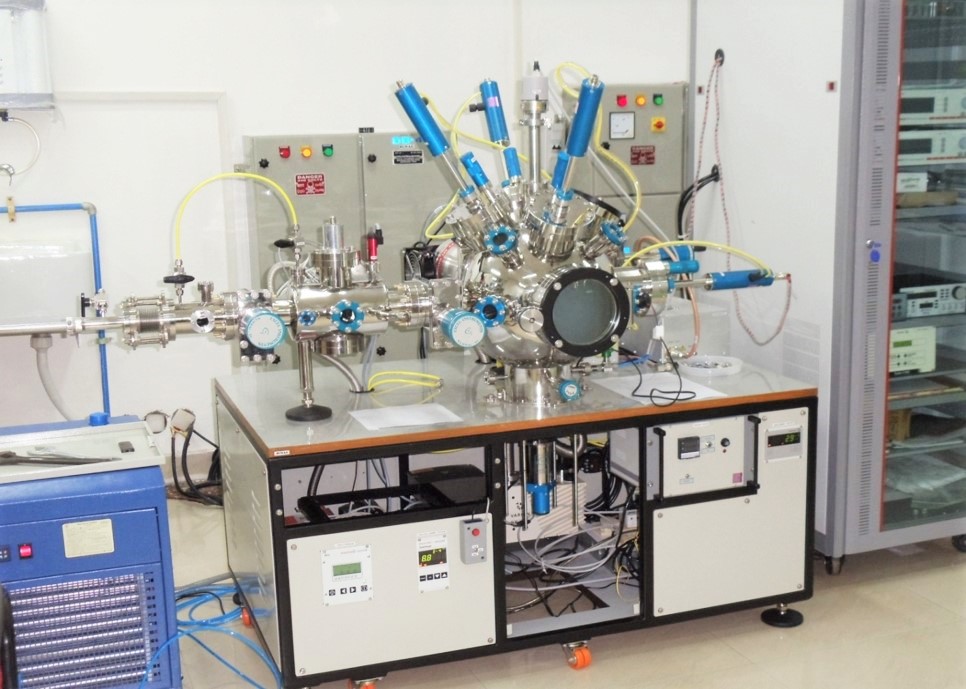
Pulsed Laser Deposition Setup
Pulse Laser deposition is a thin film deposition technique for different substrate-target combinations. The main feature of this technique is to transfer/preserve the stoichiometry of the target compound to the deposited thin film. This makes it very popular for complex materials thin film applications. A sophisticated pulse KrF excimer laser beam, is used to ablate on the target material with specific repetition frequency. As a result, there will be a local melting of target material, which leads to the formation of a plum with outward momentum. Later on the particles which get ablated from the target material, stick uniformly to the substrate. Deposition can be done with /without substrate and/or target rotation with variable substrate temperature.
Manufacturer: Excel Instruments
Laser Source Type: KrF Excimer Laser
Excimer Laser Model: Coherent
Date of installation: September, 2012
Features:
Laser Wavelength: 248 nm
Repetition Rate: 1 to 10 Hz
Pulse Duration: 20 ns
Maximum Average Power: 10 Watts.
Deposition Temperature: RT to 1200oC
No. of Materials Deposited Simultaneously: 6
Target Rotation During Deposition: 3 rpm
Substrate Rotation During Deposition: Yes
Vacuum Level: 1×10-7 mbar
Gases Used: Ar, O2, N2 etc.
Laser Source Type: KrF Excimer Laser
Excimer Laser Model: Coherent
Date of installation: September, 2012
Features:
Laser Wavelength: 248 nm
Repetition Rate: 1 to 10 Hz
Pulse Duration: 20 ns
Maximum Average Power: 10 Watts.
Deposition Temperature: RT to 1200oC
No. of Materials Deposited Simultaneously: 6
Target Rotation During Deposition: 3 rpm
Substrate Rotation During Deposition: Yes
Vacuum Level: 1×10-7 mbar
Gases Used: Ar, O2, N2 etc.
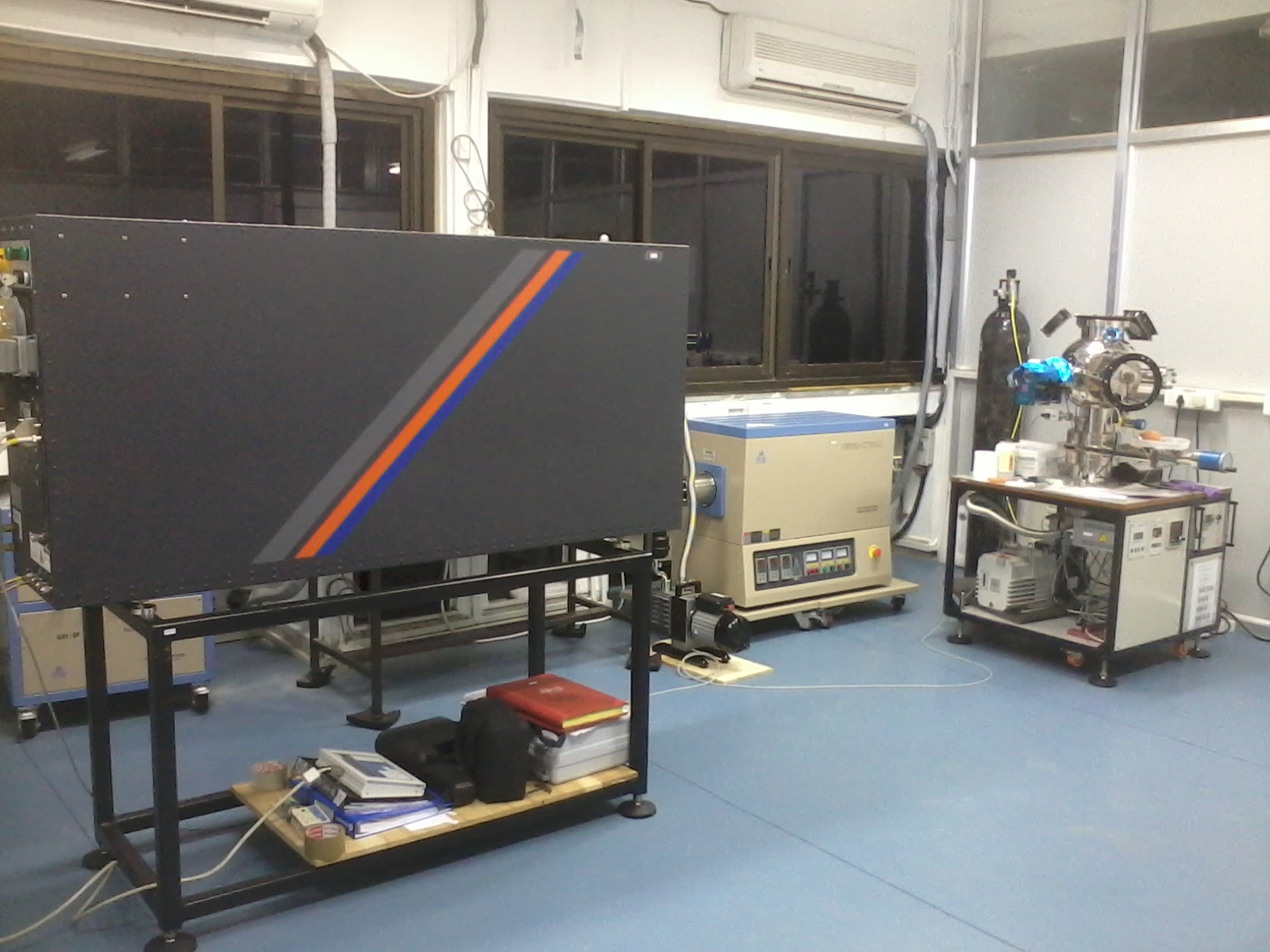
UHV Electron Beam Evaporation Setup
The Electron Beam Evaporation process is one of the Physical Vapor Deposition (PVD) technique. Deposition processes are used to release a material from a source and transfer that material to a substrate, forming a thin film or coating. PVD processes are commonly used for the deposition of metals, because they can be performed at lower process risk and cheaper in regards to materials cost that Chemical Vapor Deposition (CVD).
In the evaporation process, a block of the material (source) to be deposited is heated to the point where it starts to boil and evaporate. Then it is allowed to condense on the substrate-the material that you want to coat. This process takes place inside a vacuum chamber, enabling the molecules to evaporate freely in the chamber, where they then condense on all surfaces. For e-beam evaporation, an electron beam is used to heat the source material and cause evaporation. Electron beam evaporation is a commonly used process for coating lenses and filters with anti-reflection, scratch-resistant or other specialized coatings. The process is also commonly used for coating insulating and resistor films on electronic components
Manufacturer: Excel Instruments
E-Beam Source Model: Telemark Model-568
E-Beam Source Power supply: Telemark TT-6
Date of installation: May, 2010
Features:
E-Beam Deflection: 270o
Accelerating Voltage Range: 4 KV to 9 KV
Emission Current: 0 to 670 mA @ 9 KV
Max. Filament Power: 600 Watts
(50 Amps. & 12 VAC max.)
Coil Resistance: Lateral: 8.5 Ω ;
Longitudnal: 7.5 Ω
E-Beam Source Model: Telemark Model-568
E-Beam Source Power supply: Telemark TT-6
Date of installation: May, 2010
Features:
E-Beam Deflection: 270o
Accelerating Voltage Range: 4 KV to 9 KV
Emission Current: 0 to 670 mA @ 9 KV
Max. Filament Power: 600 Watts
(50 Amps. & 12 VAC max.)
Coil Resistance: Lateral: 8.5 Ω ;
Longitudnal: 7.5 Ω
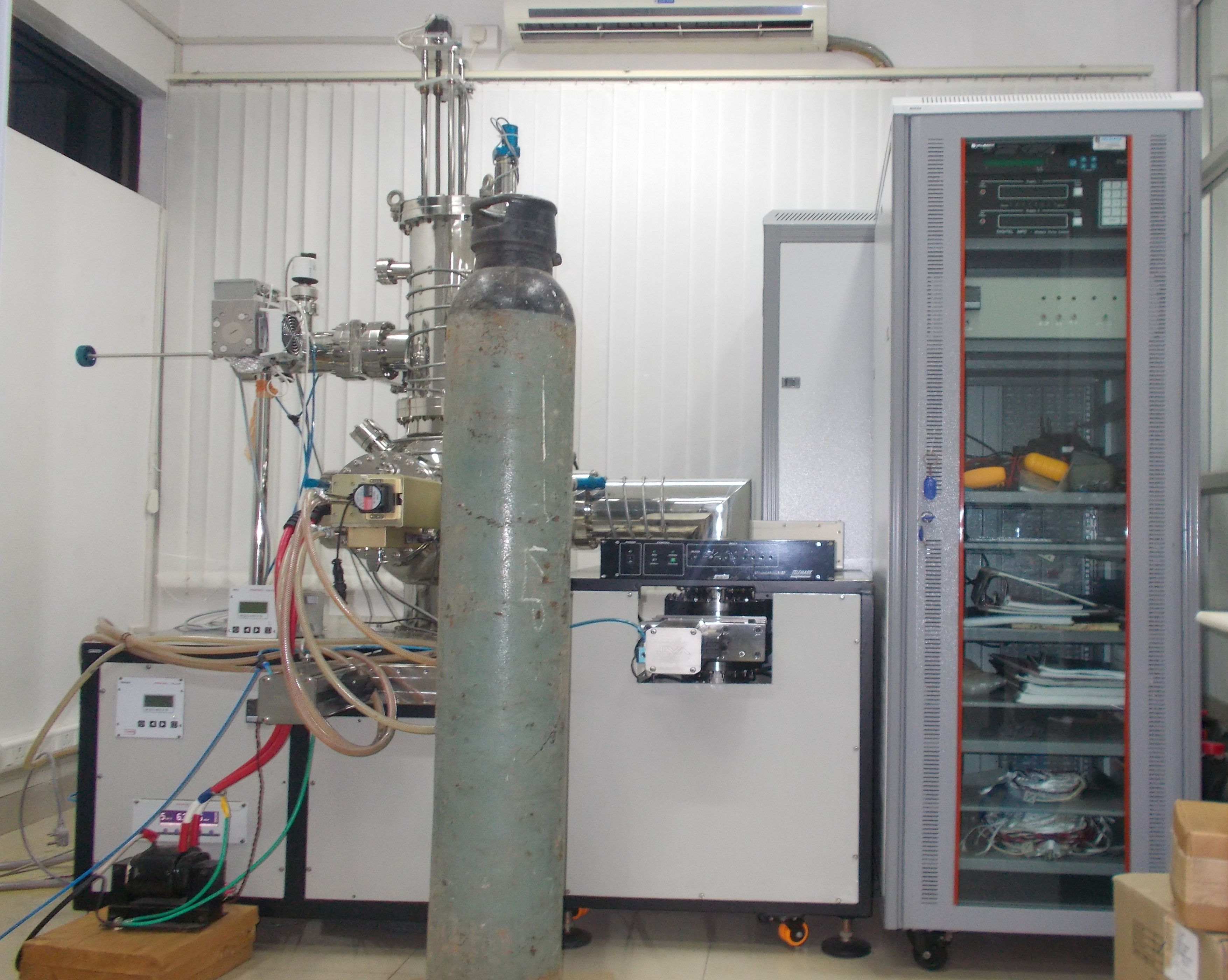
Scanning Probe Microscope
Scanning probe microscope is one of the high-resolution imaging tool performs a complete range of AFM techniques for surface characterization of properties like topography, charge-mapping, elasticity, grain boundary mapping, Surface Potential/Capacitance mapping, friction, adhesion, work-function-mapping and electrical/magnetic fields. User-friendly,compact hardware design and powerful software enable the MultiMode SPM to easily acquire data from micro- to atomic-scale images. Atomic force microscopy is a powerful surface analytical technique can be used in air, liquid or vacuum environments to produce very high-resolution topographic images of a surface down to atomic/molecular resolution. Depending on the sharpness of the tip and degree of vacuum it can provide spatial resolutions of 1-20 nm. Vibration isolation table is useful for reducing noise level. This can work mainly in 3 modes. One is Noncontact Mode which is based on the principle of amplitude modulation detection. In this mode, tip approaches the sample and the van der Waals attractive force between the tip and the sample causes some changes in both the amplitude and the phase of the cantilever vibration. Second one is the Contact Mode, where the tip scans the sample in close contact with the surface used for higher resolution topographical images of relatively hard materials. The third one is a Intermittent contact Mode or tapping mode, is the common mode which takes advantages of both the Contact mode and NonContact mode. TappingMode imaging overcomes the limitations of the conventional scanning modes by alternately placing the tip in contact with the surface to provide high resolution and then lifting the tip off the surface to avoid dragging the tip across the surface. It can record topographic images as well as providing some information of chemical, mechanical (modulus, stiffness, viscoelastic, frictional), electrical and magnetic properties at nanoscale.
Manufacturer: Asylum Research
Model: MFP 3D
Date of installation: December, 2009
Features:
Vibration Isolation
Data Acquisition: > 5k x 5k point images
Scan Axes:
X&Y: 90µm travel in closed loop;
sensor noise <0.5nm;
Z: >15µm sensored travel;
Sensor noise <0.25nm
X, Y, & Z High Voltage Outputs: -10 to +150V.
Light Source: Superluminescent diode
Operational Modes:
Model: MFP 3D
Date of installation: December, 2009
Features:
Vibration Isolation
Data Acquisition: > 5k x 5k point images
Scan Axes:
X&Y: 90µm travel in closed loop;
sensor noise <0.5nm;
Z: >15µm sensored travel;
Sensor noise <0.25nm
X, Y, & Z High Voltage Outputs: -10 to +150V.
Light Source: Superluminescent diode
Operational Modes:
- Force Mode,
- Contact Mode,
- AC and Dual AC Mode,
- Conductive AFM,
- Magnetic Force Microscopy,
- Piezoresponse Force Microscopy,
- Scanning Kelvin Probe Microscopy etc.
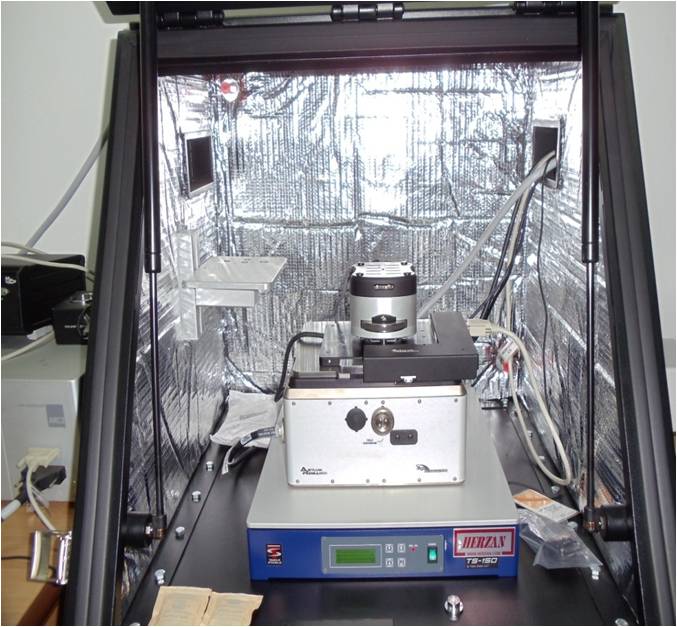
High-resolution X-Ray Diffraction Setup
This is a versatile high resolution X-ray diffractometer that use a Cu anode as the X-ray source and is equipped with Gobel mirror in the x-ray optical path for production of monochromatic high intensity Cu Kα x-ray beam with less than 0.05o divergence. The system has a NaI scintillation detector and also a LYNXEYE array detector which enables rapid and accurate data collection for crystalline materials, thin films and nano-structured material. In addition to conventional phase analysis and structural studies, the parallel beam geometry makes it possible to do advanced analysis like Grazing incidence X-ray diffraction, roughness and electron density profiling by reflectometry, stress-strain analysis by high resolution XRD, reciprocal space mapping etc.
Manufacturer: BRUKER AXS, Germany
Power supply Model: D8 DISCOVER
Date of installation: November, 2010
Features:
X-Ray Used: Cu Kα (0.15418 nm)
Max. applied power to X-ray tube: 1600 Watts (40 KV, 40mA)
Sample manipulation: 1/4 Eulerian Cradle
Translation stage: X, Y and Z
Sample Rotation: φ and χ
Detector angle (2θ) Range: 0-80o
Detector Type: Lynx Eye/PathFinder
Scan Speed: 0.01-5 Sec./Step
Operational Modes: Bragg-Brentano, HRXRD, GIXRD, XRR, and RSM etc.
Power supply Model: D8 DISCOVER
Date of installation: November, 2010
Features:
X-Ray Used: Cu Kα (0.15418 nm)
Max. applied power to X-ray tube: 1600 Watts (40 KV, 40mA)
Sample manipulation: 1/4 Eulerian Cradle
Translation stage: X, Y and Z
Sample Rotation: φ and χ
Detector angle (2θ) Range: 0-80o
Detector Type: Lynx Eye/PathFinder
Scan Speed: 0.01-5 Sec./Step
Operational Modes: Bragg-Brentano, HRXRD, GIXRD, XRR, and RSM etc.

Spectral Response Setup
The spectral response is conceptually similar to the quantum efficiency. The quantum efficiency gives the number of electrons output by the solar cell compared to the number of photons incident on the device, while the spectral response is the ratio of the current generated by the solar cell to the power incident on the solar cell. The spectral response system includes a lamp and monochromator for a tunable light source, coupled to a high sensitivity source meter with measurement software. This allows the ability to do baseline studies for solar cells
Manufacturer: Sciencetech (Canada)
Model: PTS-1-SR
Date of installation: ../../....
Features:
Sample holder: Four probe module
Lamp power: 150 Watts Xenon lamp
I-V meter: 2400 Keithley
Scan wavelength range: 200-2200 nm
★ Standard Analytical informations obtainable using software are Spectral response, I-V measurement, Open circuit voltage ( Voc ), Short circuit current ( Isc ), maximum power ( Pmax ), and Fill factor ( Ffill ).
Model: PTS-1-SR
Date of installation: ../../....
Features:
Sample holder: Four probe module
Lamp power: 150 Watts Xenon lamp
I-V meter: 2400 Keithley
Scan wavelength range: 200-2200 nm
★ Standard Analytical informations obtainable using software are Spectral response, I-V measurement, Open circuit voltage ( Voc ), Short circuit current ( Isc ), maximum power ( Pmax ), and Fill factor ( Ffill ).
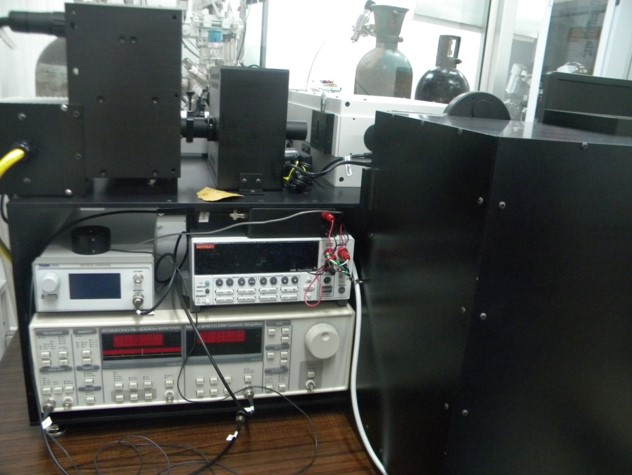
Fluorescence Spectrometer
UV-Vis-NIR spectrometer is one of the powerful tool for optical characterization of thin film solar cells mainly. It utilizes two light sources, one is Deuterium and other one is mercury, to study the transmission, reflection, and absorption properties of materials over the complete range of solar spectrum.One standard sample is used for calibration.
Detector System Manufacturer: Horiba scientific, USA
Spectrometer Model: TRIAX-77200
Spectrometer Manufacturer: ORIEL Instruments, USA
UV Arc Lamp Model: '68820' 1000 W Hg(Xe) Lamp
UV Arc Lamp Manufacturer: ORIEL Instruments, USA
Date of installation: ../../....
Features:
Focal Length: 19 cm
Grating Size: 50 mm &multi; 50mm
Scanning Range: 0 - 1400 nm
Spectrometer Model: TRIAX-77200
Spectrometer Manufacturer: ORIEL Instruments, USA
UV Arc Lamp Model: '68820' 1000 W Hg(Xe) Lamp
UV Arc Lamp Manufacturer: ORIEL Instruments, USA
Date of installation: ../../....
Features:
Focal Length: 19 cm
Grating Size: 50 mm &multi; 50mm
Scanning Range: 0 - 1400 nm
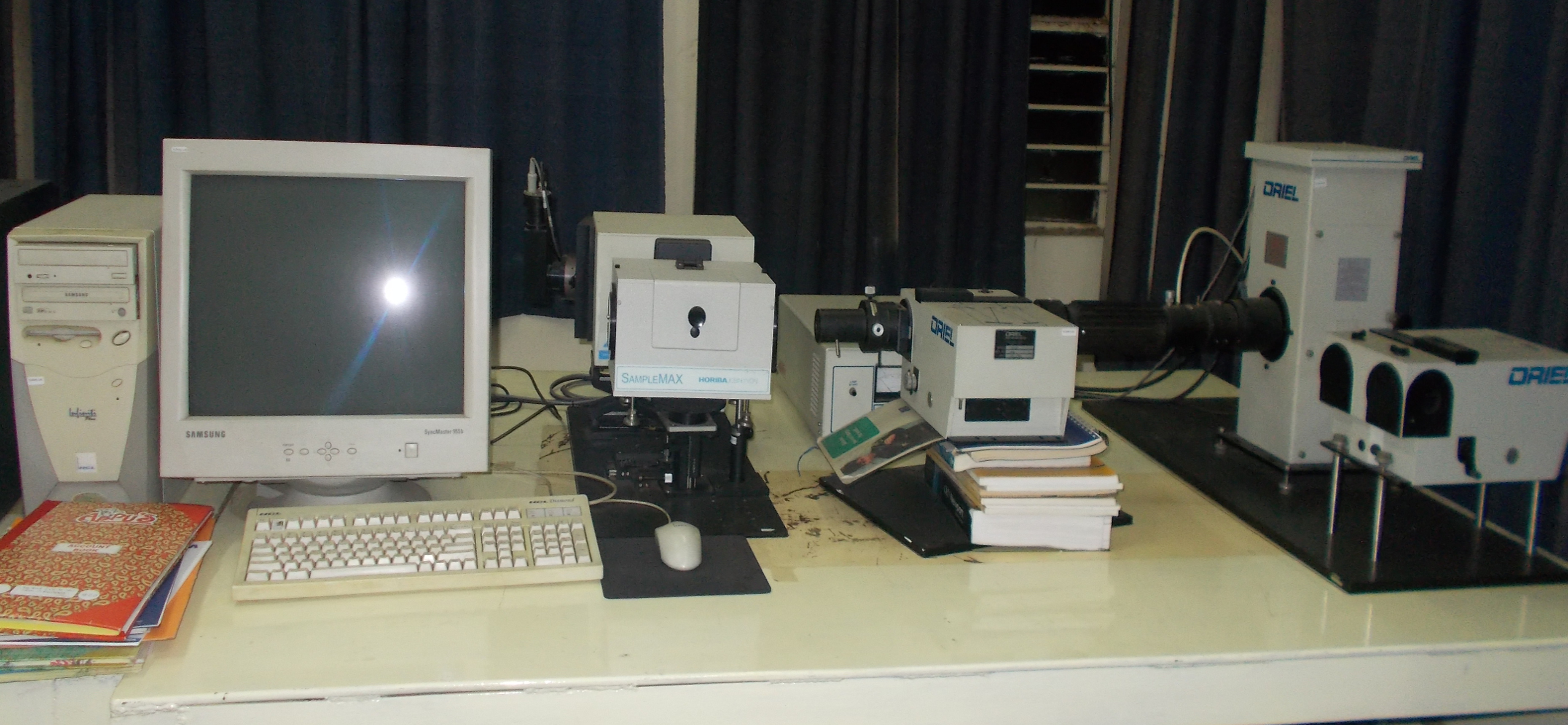
Field Emission Setup
Field emission (FE) (also known as field electron emission and electron field emission) is emission of electrons induced by an electrostatic field. It is a quantum effect where under a sufficiently high external electric field, electrons near the Fermi level can tunnel through the energy barrier and escape to the vacuum level. The most common context is field emission from a solid surface into vacuum. However, field emission can take place from solid or liquid surfaces, into vacuum, air, a fluid, or any non-conducting or weakly conducting dielectric. The field-induced promotion of electrons from the valence to conduction band of semiconductors can also be regarded as a form of field emission.
Model F. E. Sys. - 150
Manufacturer: Excel Instruments
Power supply Model: 2410 Keithley source metre
Date of installation: October, 2012
Features:
Tip diameters: 2.5 mm, 5 mm, and 20 mm.
Target diameter: 2 inch
Sample to tip distance: 20-1000 µm
Maximum field applied: 1100 Volts
Vacuum level: 1×10-7 mbar
★ Standard Analytical informations obtainable using software for Field emission and FE stability
Manufacturer: Excel Instruments
Power supply Model: 2410 Keithley source metre
Date of installation: October, 2012
Features:
Tip diameters: 2.5 mm, 5 mm, and 20 mm.
Target diameter: 2 inch
Sample to tip distance: 20-1000 µm
Maximum field applied: 1100 Volts
Vacuum level: 1×10-7 mbar
★ Standard Analytical informations obtainable using software for Field emission and FE stability

High Temperature Box Furnaces
High Temperature Vacuum Box Furnaces
High Temperature Vacuum Furnaces system is a post processing tool for the study of temperature dependent properties of different elemental as well as complex single layered or multi-layered thin films or bulks in high order vacuum or any gaseous environments.It can swap the temperature range from liquid nitrogen temperature to 1100oC
Manufacturer: MTI Corporation
Furnace box Model: OTF - 1200X
Date of installation: March, 2012
Features:
Annealing Temperature Range: RT to 1100oC
Temperature controller PID control method with over-temp protection
Positive Pressure Sensor: Yes
Pressure Measurement Range 0~15 Mpa
Pressure Alarm System: Upper and lower limit control method with warning alarm
Power 2.5 KW
Vacuum level: 1×10-7 mbar
★ Annealing can be done in vacuum or any gaseous environments
Furnace box Model: OTF - 1200X
Date of installation: March, 2012
Features:
Annealing Temperature Range: RT to 1100oC
Temperature controller PID control method with over-temp protection
Positive Pressure Sensor: Yes
Pressure Measurement Range 0~15 Mpa
Pressure Alarm System: Upper and lower limit control method with warning alarm
Power 2.5 KW
Vacuum level: 1×10-7 mbar
★ Annealing can be done in vacuum or any gaseous environments

High Temperature Ambient Box Furnaces
High Temperature Ambient Furnaces system is a post processing tool for the study of
temperature dependent properties of different elemental as well as complex single layered or multi-layered thin
films or bulks in ambient condition.It can swap the temperature range from liquid nitrogen temperature to 1100oC
Manufacturer: MTI Corporation
Furnace box Model: SWGL - 1700X
Date of installation: March, 2012
Features:
Annealing Temperature Range: RT to 1100oC
Temperature controller PID control method with over-temp protection
Positive Pressure Sensor: Yes
Pressure Measurement Range 0~15 Mpa
Pressure Alarm System: Upper and lower limit control method with warning alarm
Power 2.5 KW
★ This Furnace can work in 3 zones simulataneously at different temperatures controlled by PID
Furnace box Model: SWGL - 1700X
Date of installation: March, 2012
Features:
Annealing Temperature Range: RT to 1100oC
Temperature controller PID control method with over-temp protection
Positive Pressure Sensor: Yes
Pressure Measurement Range 0~15 Mpa
Pressure Alarm System: Upper and lower limit control method with warning alarm
Power 2.5 KW
★ This Furnace can work in 3 zones simulataneously at different temperatures controlled by PID
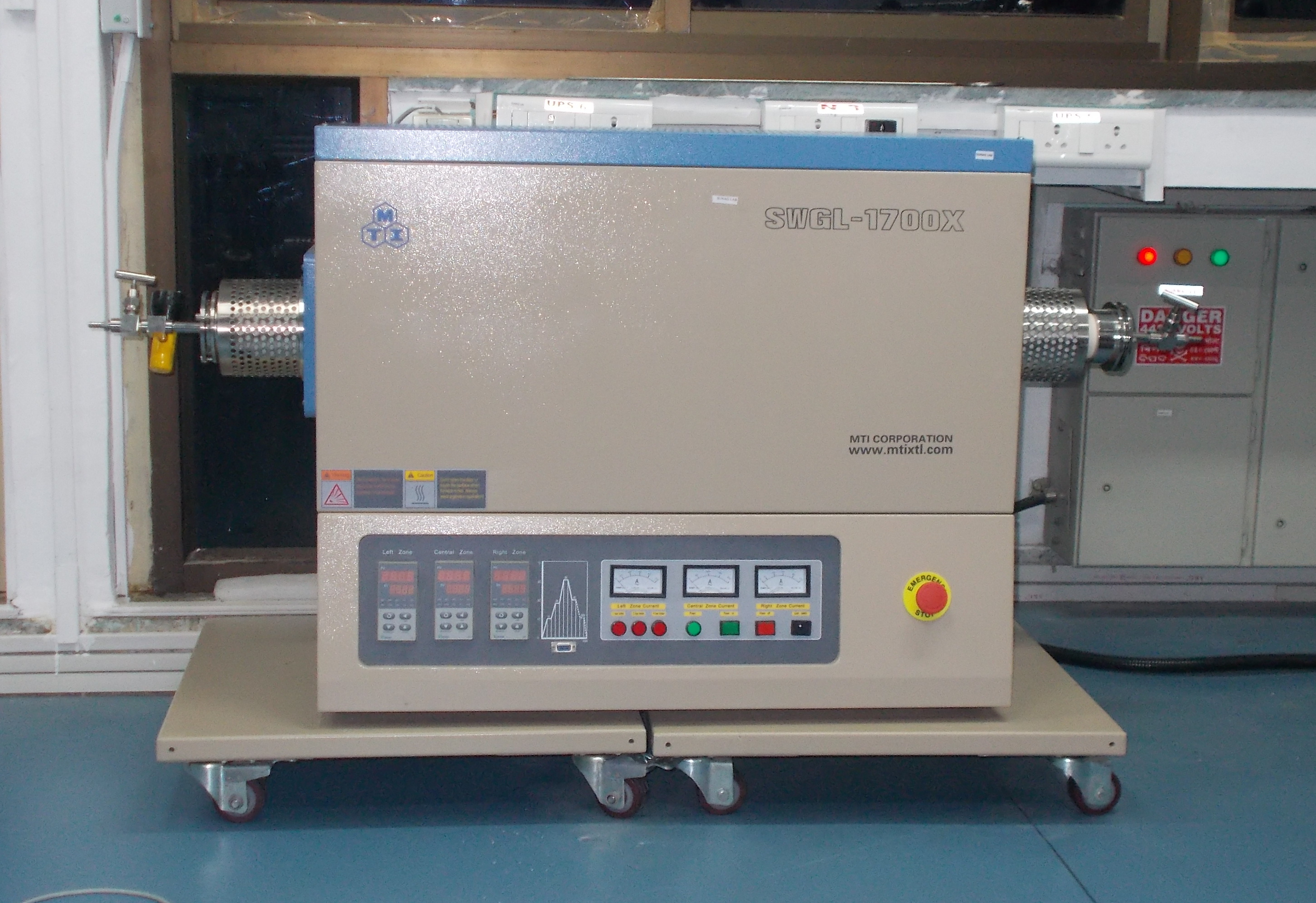
Surface Profilometer
Surface profiler measures roughness, waviness, and step height in a variety of applications. It works on deflection height measurement mechanism and magneto static force control system. It is capable of measuring soft films and substrates without surface damage with precision step heights from under 10 angstroms to as large as 1.2 millimeters.
Manufacturer: Ambios Technology
Model: XP 200
Date of installation: ../../....
Features:
Sample stage diameter: 200mm
Scan length range: 55 mm
Sample thickness: 30 mm
Vertical resolution: 0.38Å Least Significant bit
Lateral resolution: 100 nm (Stylus dependent)
Vertical range: 1200nm (max.)
Stress option: Yes
Sample viewing: Color camera
Stylus force range: 0.03-10 mg
★ Used For Stress analysis, Step detection, Skewness & Height histogram
Model: XP 200
Date of installation: ../../....
Features:
Sample stage diameter: 200mm
Scan length range: 55 mm
Sample thickness: 30 mm
Vertical resolution: 0.38Å Least Significant bit
Lateral resolution: 100 nm (Stylus dependent)
Vertical range: 1200nm (max.)
Stress option: Yes
Sample viewing: Color camera
Stylus force range: 0.03-10 mg
★ Used For Stress analysis, Step detection, Skewness & Height histogram

Ultrasonic Cleaning Unit
An ultrasonic cleaner is a sample cleaning device that uses ultrasound (usually from 20-400 kHz) and an appropriate cleaning solvent like Acetone, DI Water, Propanol etc. a series of Piezoelectric crystals are employed to generate ultrasonic waves to the solvent liquid. The surface nearer to the piezoelectric crystals produces pressure difference with respect to the other surfaces and this pressure difference is compensated as a result of creation of air bubbles directed outward the piezoelectric surface. these bubbles hits the sample surface frequently and removes adsorbed foreign species from the sample. After successively and alternatively using of different solvent liquids, the samples surfaces set free of contaminations.
Manufacturer: Telsonic
Model: TMC600
Date of installation: ../../....
Features:
Internal dimension: 505 mm x 300 mm x 200 mm
Tank content: 28 litres
Temperature range: 20 -80°C
Adjustable timer range: 1-250 minutes
Frequency harmonisation: Automatic
Nominal operating frequency: 30 kHz with frequency modulation
Accessories: Cover, basket, perforated cover, glass beaker, mini-basket for glass beakers, etc.
Model: TMC600
Date of installation: ../../....
Features:
Internal dimension: 505 mm x 300 mm x 200 mm
Tank content: 28 litres
Temperature range: 20 -80°C
Adjustable timer range: 1-250 minutes
Frequency harmonisation: Automatic
Nominal operating frequency: 30 kHz with frequency modulation
Accessories: Cover, basket, perforated cover, glass beaker, mini-basket for glass beakers, etc.

Ductless Fume Cabinet
Fume cabinet provide protection by removing chemical fume contaminants within the work area. But it is only suitable for fixed, static, and lower level chemical applications. Ductless fume cabinet has activated carbon as filtering material which removes chemical fumes by physical adsorption.
Manufacturer: Esco
Model: ADC-4BX
Date of installation: ../../....
Features:
Internal dimension: 1270 mm ×642 mm ×765 mm
Standard Filtration element: Main filter: Activated Carbon
Pre-filter: Washable non-woven polyester fibres
Power supply Options: Yes
Model: ADC-4BX
Date of installation: ../../....
Features:
Internal dimension: 1270 mm ×642 mm ×765 mm
Standard Filtration element: Main filter: Activated Carbon
Pre-filter: Washable non-woven polyester fibres
Power supply Options: Yes
